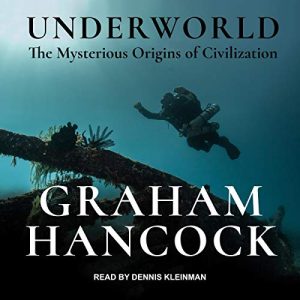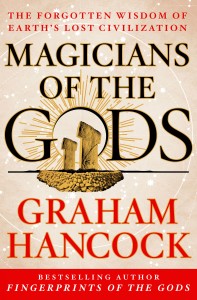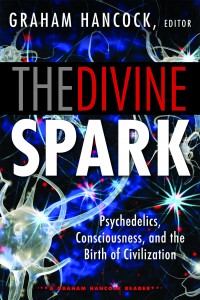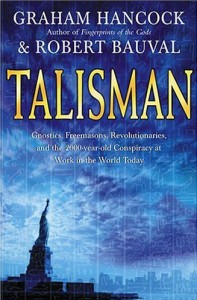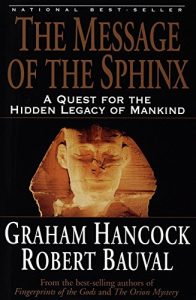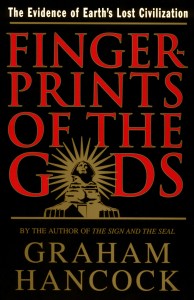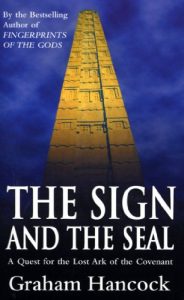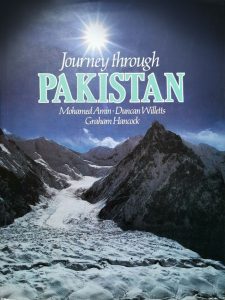Underworld: Flooded Kingdoms of the Ice Age (2002)
by Graham Hancock
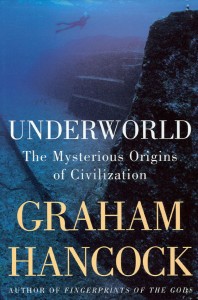
A physical and intellectual journey, a worldwide exploration diving for the underwater ruins of a lost civilization, this book follows clues in ancient scriptures and mythlogy and in the scientific evidence of the flood that swept the Earth at the end of the last Ice Age. This text explores the question of early humans swept away by the catastrophe. Who were these populations – pre-civilised hunter-gatherers or more sophisticated peoples altogether? The text is written as a personal adventure involving the reader in the travels, the practicalities and the risks while developing the larger themes along the way, building up to the explosive revelation of a global mystery.
Chapter Twenty-Seven
Confronting Yonaguni
The question was, or is still, is it and, if yes, to what extent is it made by man or overworked by man? This is the question.
I was in Tokyo in 1996 when the photojournalist Ken Shindo showed me the first images I had ever seen of an awe-inspiring terraced structure, apparently a man-made monument of some kind, lying at depths of up to 30 metres off the Japanese island of Yonaguni at the remote south-west end of the Ryukyu archipelago.
This was the moment, if there ever was just one moment, when the “Underworld” quest began for me and when much that I had learnt in previous years in many different countries began to swing sharply into focus and make sense. I felt an immediate compulsion to explore the beautiful and mysterious structure that beckoned so alluringly from the photographs. And I realised that it would rewrite prehistory if it could indeed be proved to be man-made.
I described in Chapter One how Santha and I learned to dive, and the remarkable synchronicities and good fortune that brought us to Yonaguni in March 1997 to begin a systematic programme of underwater photography and research there that was to continue until mid-2001. I also described some of the other rock-hewn underwater structures that we dived at with our Japanese colleagues at other locations in the Ryukyus – notably at Kerama, Aguni and Chatan at the northern end of the archipelago.
The most complex and intractable problem shared by all of these otherwise very different structures is also the simplest and most obvious question that anyone might wish to ask about them: were they shaped and carved by human hands or could they have ended up looking the way they do as a result of natural weathering and the erosive weapons of the sea?
Though they have an important role to play, geologists are not the only people qualified to decide the answer to such a question. Likewise, though they too are indispensable, archaeologists cannot be the final arbiters. On the contrary, if ever a multi-disciplinary approach was called for then it is here!
For as I’ve tried to show in the previous chapters Japan confronts us with a prehistoric cultural and mythological context into which the rock-hewn structures fit snugly like the missing pieces of a jigsaw puzzle. This context includes a clear tradition of unknown antiquity — still manifest in the present day – in which huge rocks are carved and rearranged amidst sacred natural landscapes. Since this is precisely the puzzling and ambiguous aspect – part natural and part man-made – of the underwater structures scattered around the Ryukyu archipelago, it is foolish and irresponsible to ignore the possibility of a connection.
Yet it is equally foolish and irresponsible to ignore what geology and archaeology have to say on the matter.
So it is time, I think, to provide a thorough reckoning.
The Three Geologists
Three qualified geologists — Masaaki Kimura , Robert Schoch and Wolf Wichmann — have dived at Yonaguni, acquired first-hand experience of the underwater structures, and commented publicly on what they saw. So far as I know, they are, at time of writing, the only geologists ever to have dived there. Therefore when we speak of ‘geological opinion’ concerning the Yonaguni anomalies it is important to be clear that we are referring to the work and ideas of just three men who, moreover, do not agree with one another – so there is no concensus. Other geologists who have expressed views without diving at Yonaguni hardly qualify to participate in the debate.
Since there are grave issues at stake concerning our understanding of prehistory and the story of human civilisation I propose to devote the necessary space in this chapter to an accurate summary of the views of the three main geological protagonists.
Dr kimura
The doyen of the group, and in my view the hero of the Yonaguni saga for his determination, persistence and refreshingly open-minded intellectual approach, is Dr Masaaki Kimura, Professor of Marine Geology at the University of the Ryukyus in Okinawa. He and his students have completed hundreds of dives around the main “terrace” monument at Yonaguni as part of a long-term project in which they have thoroughly measured and mapped it, produced a three-dimensional model, taken samples of ancient algae encrusted on its walls for carbon-dating, and sampled the stone of the structure itself. Professor Kimura’s unequivocal conclusion, based on the scientific evidence, is that the monument is man-made and that it was hewn out of the bedrock when it still stood above sea-level — perhaps as much as 10,000 years ago. The principal arguments that he puts forward in favour of human intervention are on the record and include the following:
1. “Traces of marks that show that human beings worked the stone. There are holes made by wedge-like tools called kusabi in many locations.”
2. “Around the outside of the loop road [a stone-paved pathway connecting principal areas of the main monument] there is a row of neatly-stacked rocks as a stone wall, each rock about twice the size of a person, in a straight line.”
3. “There are traces carved along the roadway that humans conducted some form of repairs.”
4. “The structure is continuous from under the water to land, and evidence of the use of fire is present.”
5. “Stone tools are among the artefacts found underwater and on land.”
6. “Stone tablets with carving that appears to be letters or symbols, such as what we know as the plus mark ‘+’ and a ‘V’ shape were retrieved from under water.”
7. “From the waters nearby, stone tools have been retrieved. Two are for known purposes that we can recognise, the majority are not.”
8. “At the bottom of the sea, a relief carving of an animal figure was discovered on a huge stone.” (1)
9. On the higher surfaces of the structure there are several areas which slope quite steeply down towards the south. Kimura points out that deep symmetrical trenches appear on the northern elevations of these areas which could not have been formed by any known natural process.
10. A series of steps rises at regular intervals up the south face of the monument from the pathway at its base, 27 metres underwater, towards its summit less than 6 metres below the waves. A similar stairway is found on the monument’s northern face.
11. Blocks that must necessarily have been removed (whether by natural or by human agency) in order to form the monument’s impressive terraces are not found lying in the places where they would have fallen if only gravity and natural forces were operating; instead they seem to have been artificially cleared away to one side and in some cases are absent from the site entirely.
12. The effects of this unnatural and selective clean-up operation are particularly evident on the rock-cut ‘pathway’ [Kimura calls it the ‘loop road’] that winds around the western and southern faces of the base of the monument. It passes directly beneath the main terraces yet is completely clear of the mass of rubble that would have had to be removed (whether by natural or by human agency) in order for the terraces to form at all.(2)
Dr Schoch
The second geologist to dive at Yonaguni, Professor Robert Schoch of Boston University, has vacillated tenaciously in his opinions – but I take this as a sign of an open-minded scholar ever willing to revise his views in the light of new evidence.
Thus when we first dived there together in September 1997, he was sure that the structure was man-made.(3) Within a few days, however, he had changed his mind completely:
I believe that the structure can be explained as the result of natural processes The geology of the fine mudstones and sandstones of the Yonaguni area, combined with wave and current actions and the lower sea-levels of the area during earlier millennia, were responsible for the formation of the Yonaguni Monument about 9000 to 10,000 years ago.(4)
A few days later, Schoch softened his position again:
After meeting with Professor Kimura, I cannot totally discount the possibility that the Yonaguni Monument was at least partially worked and modified by the hands of humans. Professor Kimura pointed out several key features that I did not see on my first brief trip If I should have the opportunity to revisit the Yonaguni monument, these are key areas that I would wish to explore.(5)
Schoch did have an opportunity to revisit the structure in the summer of 1998, carrying out several more dives there. Then in 1999 in an interview given to the BBC science programme “Horizon” for a documentary attacking my work – and in the same year in his own book “Voices of the Rocks” — he expressed what sound like two very different, even contradictory opinions about the structure.
Here is the relevant section from the BBC Horizon transcript:
NARRATOR: “Yonaguni looked as if it could be a spectacular discovery and Hancock needed corroboration. He invited the Boston University geologist Robert Schoch to inspect the site. Professor Schoch has taken a keen interest in unorthodox views of the past and he welcomed the chance to examine the underwater discovery. Schoch dived with Hancock several times at Yonaguni.”
PROF. ROBERT SCHOCH (Boston University): “I went there in this case actually hoping that it was a totally man-made structure that was now submerged underwater, that dated maybe back to 6,000 BC or more. When I got there and I got to dive on the structure I have to admit I was very, very disappointed because I was basically convinced after a few dives that this was primarily, possibly totally, a natural structure Isolated portions of it look like they’re man-made, but when you look at it in context you look at the shore features etc and you see how, in this case, fine sandstones split along horizontal bedding plains that gives you these regular features. I’m convinced it’s a natural structure.”(6)
Well that seems straightforward. But then here is what Schoch says in “Voices of the Rocks”:
Possibly the choice between natural and human-made isn’t simply either/or. Yonaguni Island contains a number of old tombs whose exact age is uncertain, but that are clearly very old. Curiously the architecture of the tombs is much like that of the monument. It is possible that humans were imitating the monument in designing the tombs, and it is equally possible that the monument was itself somehow modified by human hands. That is, the ancient inhabitants of the island may have partially reshaped or enhanced a natural structure to give it the form they wished, either as a structure on its own or as the foundation of a timber, mud or stone building that has since been destroyed. It is also possible that the monument served as a quarry from which blocks were cut, following the natural bedding, joint and fracture planes of the rock, then removed to construct buildings that are now long gone. Since it is located along the coast the Yonaguni Monument may even have served as some kind of natural boat dock for an early seafaring people. As Dr Kimura showed me, ancient stone tools beautifully crafted from igneous rock have been found on Yonaguni. Significantly, Yonaguni has no naturally exposed igneous rocks, so the tools, or at least the raw materials from which they were made, must have been imported from neighbouring islands where such rock is found. The tools could have been used to modify or reshape the natural stone structures now found underwater off the coast of Yonaguni. The concept of a human-enhanced natural structure fits well with East Asian aesthetics, such as the feng shui of China and the Zen-inspired rock gardens of Japan. A complex interaction between natural and human-made forms that influenced human art and architecture 8000 years ago is highly possible.(7)
As further evidence for a very ancient human role in the construction of the Yonaguni monument, Schoch then sets out an argument of mine, advanced in my 1998 book “Heaven’s Mirror”, that the structure is not only man-made but could also have served a specific astronomical function — since calculations show that around 10,000 years ago, when it was above water, it would have stood on the ancient Tropic of Cancer.(8) Writes Schoch:
The ancients, I suspect, knew where the tropic was, and they knew that its position moved slowly. Since Yonaguni is close to the most northerly position the tropic reaches in its lengthy cycle, the island may have been the site of an astronomically aligned shrine.(9)
In summary, therefore, Schoch has not come down definitively either on one side of the fence or on the other but seems to be wavering in the direction of a compromise in which the structure is both natural and man-made at the same time.
I cannot avoid adding that all rock-hewn structures, whether the weird terraced granite outcrop at Qenko near Sacsayhuaman in Peru,(10) or the wonders of Petra in Jordan, or the temples of Mahabalipuram in South India are, by definition partly natural – the base rock out of which they are hewn – and partly man-made. They can’t help but be anything else.
Dr Wichmann
The third geologist, German science writer Dr Wolf Wichmann, has definite opinions and expresses them with certainty. In 1999 he informed Der Spiegel magazine – who had taken him to Yonaguni — that he regards the underwater monument as entirely natural. He made just three dives on the main terraces and then declared:
I didn’t find anything that was man-made.(11)
Japan’s marine scientists “haven’t got a clue” what the terraced underwater structure at Yonaguni is, reports Der Spiegel:
It is unlikely to be anything natural” said the oceanographer Terukai Ishii from Tokyo. Masaaki Kimura, a marine researcher at the Rykyus University (Okinawa) talks about “a masterpiece”. He thinks the structure is a sacred edifice built by a hitherto unknown culture possessing advanced technical abilities.
‘The debate going on in the Orient has awakened the curiosity of the West. People with second sight find themselves magically attracted by “Iseki Point (“ruins”). At the beginning of 1998 the geologist Robert Schoch, who believes the Sphinx was built by the people of Atlantis [sic — completely untrue; Schoch does not believe any such thing] swam down to the site and declared it to be “most interesting”. The guru of ancient antiquity and best-selling author Graham Hancock was also investigating the site. After an excursion in a submersible he records that at the base of the monument can be seen a “clearly-defined path.” [actually I have never been in a submersible at Yonaguni and I do not consider my four years of hands-on diving there as any kind of excursion; there is, however, a clearly-defined path at the base of the monument].
‘The rock expert Wolf Wichmann could not corroborate these conclusions. In the company of a team from SPIEGEL TV he returned to explore the coastal area, under threat from tsunamis. In a total of three diving operations he gathered rock samples and measured the steps and “walls”. He was unconvinced by his findings: “I didn’t find anything that was man-made”.
‘During the inspection it was revealed that the “gigantic temple” is nothing but naturally produced bedded rock. The sandstone is traversed by vertical cracks and horizontal crevices. Perpendicularity and steps have gradually developed in the fracture zones. The plateaux at the top are referred to by Wichmann as typical “eroded plains”. Such flat areas occur when bedded rock is located right in the path of the wash of the waves.
‘Suggestive pictures rich in detail and contrast may indeed reveal something else, but in general the mass of rock looks like a structure rising out of a sandy bed, with no sign of architectural design. The plateaux have gradient sections, and there is no perpendicular wall. Some of the steps just end nowhere; others are in a spiral, like steep hen-roosts.
‘The stony blocks show no signs of mechanical working. “Had the ‘ashlars’ been hewn by tools, they would have been studded with flutes and cuts and scratches”, said Wichmann. Three circular recesses on the topmost plateau, referred to by Kimura as column foundations, are nothing but “potholes”. These occur when water washes through narrow spaces.
‘Facts like these fail to stem the current epidemic of mystery-fever. The Yonaguni monument has for some time played a key role in the world picture of archaeological dreamers.(12)
The One Archaeologist
One archaeologist has dived at Yonaguni and studied its underwater structures first hand. Others in his profession who have commented have done so from their desks after browsing through photographs or looking at videotape of the structures. As is the case with the armchair geologists, their opinions can only be of limited value until they have dived there themselves.
By contrast the opinion of the only experienced marine archaeologist in the world who has ever dived at Yonaguni must count for a great deal more.
That archaeologist — whose official report is reproduced in part below — is Sundaresh from the National Institute of Oceanography in Goa, India. The reader will recall that we dived with him and other NIO archaeologists at Dwarka in March 2000 and again at Pumpuhar in February 2001. Between these expeditions in India, Sundaresh participated with us in an expedition to Yonaguni in September 2000 that had been sponsored once again (as had Robert Schoch’s visit in September 1997) by Seamen’s Club.
Also participating in the September 2000 expedition was Kimiya Homma, a businessman from Hokkaido, whose firm owns two very useful high-tech ROVs (remotely operated vehicles) for unmanned exploration in water too deep to be readily reached by divers. So that an effective search for further structures around Yonaguni could be mounted in the short time available, Homma had brought one of the ROV’s with him and also an expert team of support staff and technical divers.
Because it is a unique document of reference, being – so far – the first and only evaluation of a wide range of Yonaguni’s underwater structures by a marine archaeologist, I reproduce below several sections from Sundaresh’s expedition report. Some of the specific submerged sites that we visited with Sundaresh during the expedition are not yet familiar to the reader from the brief account given in Chapters 1 and 25 but will be described shortly:
THE STUDY OF SUBMERGED STRUCTURES OFF YONAGUNI ISLAND OF JAPAN: THE PRELIMINARY RESULTS FROM RECENT EXPEDITION
1-12 September 2000
BY SUNDARESH
NATIONAL INSTITUTE OF OCEANOGRAPHY
DONA PAULA, GOA 403 004
DECEMBER 2000
1.0 INTRODUCTION
Yonaguni is the most south western island of Japan and closest to Taiwan (about 69 nautical miles). This island is almond shaped with 10 km length from (east to west) and 4 km width (north to south). An international expedition was organized by the Seamen’s Club, Ishigaki Japan to further explore the underwater structures in the area. This report describes the archaeological significance of the structures found during the expedition.
2.0 BACKGROUND INFORMATION OF THE AREA
Underwater massive structures were found initially by Mr. Aratake a local resident of Yonaguni island during 1986-87. He named this point as Iseki (“Monument”) Point. He was looking for hammerhead sharks schooling around the island, when a massive man-made underwater structure was noticed at a depth of 30 m. This was his first discovery. Later more monuments were found by Aratake and other divers in nearby Tatigami and “Palace” areas.
4.0 METHODOLOGY
4.1 Offshore Explorations
Two boats were chartered for explorations off Yonaguni waters from 2 September 2000 to 8 September 2000. The Remotely Operated Vehicle (ROV) was deployed simultaneously with side scan sonar and echosounder. The ROV was operated with generator power supply. The system was operated in waters between 40 to 80 metres depth around Yonaguni. The survey revealed rock cut channel about 1 m wide and more than 20 m long at 2 sea mounts. The ROV observations were confirmed by diving.
5.0 RESULTS
5.1 Terraced Structure and Canal
A large terraced structure of about 250 metres long and 25 metres height was studied south of the Arakawabana headland. Known locally as Iseki Point, the terraced structure is bound to the northern side of an elongated, approximately east-west trending structure, designated by Professor Masaaki Kimura, University of the Ryukyus, as an approach road. But our observation of the proposed road-like structure suggests that it is more likely to be a canal. The overall width of the terraced structure is around 100m. From each of the terraces; a staircase leads downwards to the canal(road ?).
The length of the canal appears to be more than 250 m, while the canal has a width of 25 m. The purpose or utility of this canal structure is intriguing. Our observation all along the canal indicates that, the western end of the structure begins underwater opening away from the terraced structure into the open sea. The width, height and terraced northern side of the canal force us to suggest that the canal structure might have served as a channel for small boats communicating with the Arakawabana headland. The southern natural outcrop wall probably had provided a buffer wall for strong open sea waves. This interpretation appears quite reasonable because the height of the southern wall of natural outcrop and the northern terraced wall are nearly same. The terraces and attached staircases might have been used for handling, loading and unloading boats sailing through the channel. Thus it appears in all probability that the terraced structure and canal might have served as a jetty before submergence to present depth.
5.2 Monolith Human Head
A large monolith that looks like a human head with two eyes and a mouth was studied at Tatigami Iwa Point. A human-cut large platform in the same monolith extends outwards at the base of the head. An approach way leads to this platform from the shore-side.
The surrounding basal platform is quite large (about 2500m2 ), and could easily have accommodated more than two thousand persons sitting. The human head and associated platform with an approach road are suggestive of an area of worship or community gatherings.
5.3 Underwater Cave Area
Diving operations revealed caves at 8 to 10 m water depth at “Palace” area. The entry to these caves was possible only through the large 1 metre radius holes on the cave roof. Inside the cave a boulder about 1 metre diameter engraved with carvings was observed. About 100 m towards the eastern side of the caves more rock engravings were noticed on the bedrock. These rock engravings are believed to be man-made.
Once upon a time these caves were probably on the land and were later submerged. The rock engravings inside the cave and on the bedrock were probably carved out by means of a tool of some sort. However, it is very difficult to say that these are rock art of this or that period, or a script.
5.4 Megaliths Point
Diving operations revealed two big rectangular blocks measuring 6 metres in height, about 2.5 metres in width (both) and 4.9 metres thickness which have been located towards the western side of Iseki point… These rectangular blocks are designated by Japanese workers as megaliths. These blocks have been located in between two natural rock outcrops. The approach way to these megaliths is through a tunnel measuring about 3 m long, 1 m high and 1 m width.
The shape, size and positioning of these megaliths suggest that they are man-made. It is believed that the people of Japan’s extremely ancient Jomon culture used to worship stones, rocks, (Hancock, personal communication, 2000). In light of this practice, it may be worthwhile to suggest that, these megaliths might have been used as objects of worship. However a thorough investigation in this regard is necessary before assigning a definite purpose to these megaliths.
6.0 CONCLUSION
The terraced structures with a canal are undoubtedly man-made, built by cutting an existing huge monolithic outcrop. The rectangular terraced structure and canal probably might have served as a jetty for handling, loading/unloading small boats before its submergence to present depth.
The monolith rock-cut human head and associated platform might have served as an area of worshiping or community gatherings.
The Score So Far
By my count so far I have one marine archaeologist, Sundaresh, who is convinced that the Yonaguni structures are “undoubtedly man-made”, and who represents 100 per cent of all the archaeologists who have ever dived there up to time of writing. I also have one marine geologist, Masaaki Kimura, who believes the same thing, a second, Robert Schoch, who is undecided, and a third, Wolf Wichmann who is convinced that they are natural.
I decided when I got the opportunity that I should try to dive at Yonaguni with Wichmann and see if I could change his mind. To this end, a few months after the Der Spiegel article appeared, I made the following statement on my website:
I would like to offer a challenge to Wolf Wichmann Let us agree a mutually convenient time to do, say, 20 dives together at Yonaguni over a period of about a week. I will show you the structures as I have come to know them, and give you every reason why I think that the monuments must have been worked on by human beings. You will do your best to persuade me otherwise. At the end of the week let’s see if either side has had a change of mind.(13)
“JAPANESE SCIENTISTS CANNOT DIVE”
In March 2001, on a mini-expedition funded by Channel 4 Television, Wichmann took up my challenge. A small, wiry, dark-haired, unpretentious man, I liked him the moment I met him, and continued to do so throughout the week that we spent diving in Japan and arguing, in a mood of amiable disagreement, about what we were seeing underwater.
Predictably we did not reach a consensus: Wolf left Yonaguni still holding most of the opinions with which he had arrived, and so did I. But I think that we each gave the other some worthy points to ponder. I know that I benefited from what amounted to a very useful field seminar on the natural history of submerged rock and began to understand clearly for the first time exactly how and why a geologist might conclude that the Yonaguni underwater structures are entirely natural – or at any rate (to sum up Wolf’s position more accurately) that they all could have been formed by known natural forces with no necessity for human intervention.
Before going on toYonaguni, Wolf and I paid a visit to Professor Masaaki Kimura at his office in the University of the Ryukyus. I started the ball rolling with a general question for Professor Kimura concerning the age of the structure:
GH: People can argue for the next five centuries about whether what we see underwater at Yonaguni is manmade or artificial. But one thing which we can hopefully get clear is how old it is when it was submerged?
So the first question I want to ask you is what is your view of the age of this structure? The last time that it was above water?
PROF KIMURA: This construction has been submerged since 6000 years ago, because the coralline algae attaching to the wall of this structure shows 6000 years.
GH: And those coralline algae, because they’re organic, you’ve been able to carbon date them?
PROF KIMURA: Yes, Carbon-14.
GH: Right. So that tells us the age of that biological item it’s 6000 years old and it’s attached to a stone structure which, therefore, must be older than that.
PROF KIMURA: It must be older, and so in general 6000 years ago the sea level at that time [was lower] So if this was made by men, this must be when this area was land it’s about 9000 or 10,000 years ago.
GH: 9000 or 10,000 years ago? So — again to clarify, because I need to get this straight, — you’re saying that 9000 or 10,000 years ago, the whole area was above water and the date of submergence would be about 6000 years ago?
PROF KIMURA: Before 6000 years ago.
GH: This is the problem with Carbon 14 isn’t it? It dates the organism, not the structure. So then you can only say that the structure is older than that, but how much older is not sure. How much work have you done on sea level change as a dating guide? And how big a factor is the possibility of sudden maybe recent land subsidence as a result of earthquake?
PROF KIMURA: Yes, I’m looking for such evidence, that is geological evidence, but there is no evidence of movement. If this area had subsided by movement it would be due to earthquakes and faulting, but there is no active fault nearby, the fringing coast is continuous, and between the beach and Iseki Point, there is no discontinuity or fault.
WOLF: I see.
GH: That makes things fairly clear then. It leaves us with the sea level issue on its own to base a date on, without complicating factors, which is great. At least we can be clear on one thing.
WOLF: I think that questions for sea level rise are very fairly proved by scientific evidence here in the area. I mean, they’re experts in their field.
GH: So you’d have no problem with the 9000 year date?
WOLF: No, no not at all. No, the question was, or is still, is it and, if yes, to what extent is it made by man or overworked by man? This is the question.
GH: Well hopefully we’ll get a chance to investigate that when we go to Yonaguni.
PROF KIMURA: We need to research much more.
WOLF: Yes.
GH [speaking to Prof Kimura]: I mean you’re practically the only person who’s done – you and your team here – have done continuous research for some years. But almost nobody else is working on it, I think, at the moment?
PROF KIMURA: Japanese scientists cannot dive.
“A VERY FINE, A VERY NICE THING”
Throughout our discussion Professor Kimura strongly maintained his commitment to the manmade character of Yonaguni’s underwater monuments – not simply on the basis of his technical findings, cited earlier which I need not repeat here, but also, and I found persuasively, because: “This kind of topography – if this has been made by nature it is very difficult to explain the shape.”
Wolf’s riposte was immediate: “So what I would say to that formation is that I’ve seen many natural formations, especially coastlines, being worked out by waves and wind, especially with the help of weapons, erosive weapons — sand and so on Seeing with the eye of a geologist or a morphologist it is, OK, a very fine, a very nice thing, but possibly made by nature.”
I asked Wolf whether in fact he had every seen anything like the Yonaguni “formation” anywhere else in the world.
“Not in that exact combination,” he replied. “This is what is surprising me; it’s a very strong, compressed combination of the different shapes and the different figures you can find naturally in the world somewhere.”
“But you don’t usually find them in combination like this?”
“No, I haven’t seen that. So that is a marvel. It is a very beautiful formation.”
“Or the work of human beings? I prompted.
“Or of that. So that’s what we’re here for.”
The Ramp
On our first dive at Yonaguni I took Wolf to a very curious structure that I had discovered in late June 1999.
It stands in 18 metres of water 100 metres to the west of the terraces of the main monument. When above sea level 8000 or 10,000 years ago I suggest that it was originally a natural and untouched rocky knoll rising about 6 metres above ground level. A curving sloped ramp 3 metres wide was then cut into the side of the knoll and a retaining wall to the full height of the original mound was left in place enclosing and protecting the outside edge of the ramp.
I lead Wolf to the base of the ramp and as we swam up it I pointed out how the outer curve of the inner wall — which rises two metres above the floor of the ramp and is formed by the body of the mound – is precisely matched by the inner curve of the outer wall, which also rises to a height of two metres above the ramp floor, so that both walls run perfectly parallel. Moreover when we swam up and over the rim of the outer wall we could see that its own outer curve again exactly matches the curves within and that it drops sheer to the sea-bed – as it should if it is indeed a purposeful wall and not simply a natural structure.
I showed Wolf that the ramp floor itself, though battered and damaged in places, must originally have had a smooth, flat surface. I also showed him what I believe may have been the function of the ramp. As one continues to follow it round it leads to a platform offering an impressive side-on view of the two huge parallel megaliths, tucked into an alcove in the northwest corner of the main monument, that constitute a spectacular landmark in the Yonaguni “underworld”.
Later we discussed what we’d seen:
GH: Okay, Wolf, the first dive we did I brought you to a structure [attempts to draw ramp structure on notepad] – I’m sorry, I’m hopeless at drawing..
WOLF: Me too [peers at drawing] OK, so I recognise it.
GH: Hey, you’re a geologist, you should be able to draw. [Continues drawing] And here is a rather nice wall going round on both sides, and in the middle is a bedrock channel or ramp. And it rises from here around to this corner and, in fact, if we follow it all the way round it leads us to a view of the megaliths. Now this wall is not a bank. It is a wall. It’s actually about half a metre wide wide. And it’s high more than 2 metres high
WOLF Round about.
GH: Above this above this ramp, whatever you want to call it. So I simply cannot understand the combination of clean bedrock here [indicates the ramp floor], admittedly very eroded and damaged – but clean bedrock here, and these heavily overgrown walls, which are definitely wall-like in appearance and rather high in the sense that they have an outer and an inner edge, and the curve of the outer edge matches the curve of the inner edge; and the same on the other wall.
To my surprise Wolf immediately admitted that this rather innocuous looking and only recently discovered structure, which he had not been shown on his previous visit, was a “real challenge”. He was later to describe it as “the most impressive thing” he had seen at Yonguni:
The most impressive thing for me was the wall, the wall which is totally covered by living organisms nowadays, which should be removed to have a look at the structure of that wall, which can also be explained as having been done possibly by nature, but to get it sure we have to do deep research on that.(14)
Nevertheless Wolf would not have been Wolf if he had not at least attempted to comeup with a calm, level-headed and unsensational geological explanation for the problem. He therefore drew my attention now to a place on land on Yonaguni called Sananudai that we had taken a look at the day before where he had shown me wall-like formations – admittedly only half a metre high – that had been formed entirely naturally:
WOLF: Okay, this is a real challenge to solve. But if you remember, the day before we have been on a platform on land – I forgot the name of the point –
GH: Sananudai?
WOLF: Right, correct. And by chance we went further down near the sea, and I showed you these encrustation patterns and maybe you remember that I..
GH: I remember distinctly; you told me that a hard patina formed on the outside of the rock and that the water softened out the inside, leaving a wall -like shape in place.
WOLF: Correct. And on the other side, the relatively soft sandstone had already begun to be removed. So And I told you that this could be a possible way that a wall can be made by nature OK, it’s a theory.
GH: It’s a theory. I mean what I saw at Sananudai was actually no curved walls running in parallel with each other, but rather straight and they were about half metre high.
WOLF: They were at beginning stage. Right. And if you had a look closer down, you would have seen that there was a little curving, not as clear as this, I have to admit. But I mean that was really the beginning stage so we don’t know.
GH: So would you want to explain those walls [on either side of the ramp] that way, as a hard patina which was preserved, and the soft part was cut out?
WOLF: At first, and then subsequently overgrown by organisms as we saw. But to get clear what that really is, so I underline repeatedly, it is a challenge, and this is the first and only explanation I have for this. But to really get clear of this fact, we should have to remove the encrustation on one spot, or just from top to the bottomThis is the only way to find out of what material this wall consists – there’s no other way; or to drill a hole through We are obliged to find out what these walls are made of. Are they made of single patterns like stones or something?
GH: Well see, I don’t I very much doubt if the walls will turn out to be made of blocks. I think they’ll turn out to be cut. I think we’re looking at a megalithic culture which cut rock. I think they cut down into the living rock, and they created the walls by cutting, and then later on the encrustation came and grew on top of the walls. That’s my theory.
WOLF: I mean, if this was the case, then it would still be very useful to have a look on the core of these. It would tell us exactly what sort of material it was – was it soft sandstone, was it hard mudstone or what else? And we would be possibly able to find any marks on them, which then would give us the clear proof
GH: So what we have here is a bit of a puzzle which needs some serious research done on it.
WOLF: Correct. That’s what I would say.
The Tunnel and The Megaliths
On our second dive we visited the twin megaliths, weighing approximately 100 tonnes each, stacked side by side like two huge slices of toast in a west-facing alcove in the northwest corner of the main monument. As noted earlier, a prime side-on view of these hulking rectangular blocks unfolds from the top of the curved sloping ramp explored on the first dive. And we’ve seen that the ramp appears to have been cut down (either by natural or human forces) between two parallel walls out of a pre-existing rocky knoll.
The knoll in turn co-joins other massive, heavily overgrown structures presumed to be outcrops of natural bedrock which form an almost continuous barricade, three metres high and five metres thick, thrown out in a loose semi-circle in front of the megaliths – all at roughly 15-18 metres water depth. The barricade is penetrated at only one point, and there only by a narrow tunnel a little over a metre wide and about a metre and a half high through which a scuba diver swimming horizontally may pass comfortably.
The tunnel itself looks “built” – as opposed to rock-hewn like so much else at Yonaguni – in the sense that each of its sides consists of two courses of huge blocks separated by straight, clearly demarcated, matching joints. There is insufficient room to stand up within the tunnel, indeed barely enough even to crouch, so when it was above water 8000 or 10,000 years ago any human entering it would have been obliged to crawl through to the other side. What is striking then, as soon as you emerge, is the way in which you now find yourself directly opposite and beneath the twin megaliths which, from this angle, rear edge-on above you like the paired sarsens at Stonehenge or the pair of upright granite megaliths worshipped since antiquity in Japan’s Ena region as “the sacred rock deity, the object of worship” (see Chapter 25).
The swim ahead to the base of the megaliths is a matter of 20 metres and you observe immediately at this point that they do not stand on the sea-bed but are elevated about two metres above it, with their bases resting on a platform of boulders, and framed in a cleft. The side of the cleft to your right is formed by the rear corner of the main terraced monument; the side to your left is formed by a lower ridge of rock which also shows signs, though to a lesser degree, of terracing. Both megaliths slope backwards at the same angle against the cleft and both are the same height (just over six metres). The megalith to the right is distinctly thicker than its otherwise near “twin” to the left. Both megaliths taper at top and bottom so that the gap between them, about the width of a fist at the midpoint, is not constant. Although roughened, eroded and pitted with innumerable sea-urchin holes, the megaliths can still be recognised as essentially symmetrical blocks, all the faces of which appear originally to have been smoothed off to match – although, again, whether the process that brought this effect about was entirely natural, or at some point involved the input of human skill and labour, remains thus far a matter of a very few contradictory professional opinions and no facts.
I allowed myself to float up, towards the surface, along the slope of the megaliths, resting my hand in the gap between them as a guide. The light was good and I could see right into the gap; looking back at me from the far recesses a plump red fish eyed me with horror and hoped that I would go away.
As I neared the top of the megaliths, submerged under just five metres of water, I began to feel the ferocious wash of waves pounding against the surrounding rocks. I clung on and for a few moments allowed my body to be tugged back and forth by the swell. Enshrouded in a cloud of foam I could see the northwest corner of the main monument still rising above me the final few metres towards the surface.
After the dive Wolf and I again discussed what we had seen and quite soon, after some fruitless trading of opinion, our argument began to focus around a single – potentially decisive – issue. Had these very striking parallel megaliths been quarried, shaped and lowered into position beside the northwest corner of the main monument by human beings? Or had they arrived there through wholly natural processes?
I had drawn another rough sketch map to which I now pointed:
GH: There’s the two blocks, and we see above them here, not very high above them, the mass of the structure which leads round to Iseki Point. Explain to me how those blocks got there.
WOLF: Okay. You have seen lots of blocks fallen down –
GH: All over the place.
WOLF: On the shoreline we saw from the ship –
GH: Many fallen blocks, yes.
WOLF: – lots of blocks have fallen down from higher parts –
GH: Agreed.
WOLF: – from beddings which have been broken, which were harder than the underlying layers; because what happens is that you get an an undercurving and undercutting of softer material under harder banks. So in my belief, these two blocks have been once one block of two sandstone banks, with either softer material in between or nothing in between, just only the bedding limits.
GH: Well, I want to know how they got where they are now.
WOLF: Okay. My opinion is that these blocks have fallen down from a very, very high level, relative to their present situation.
GH: But no high point overlooks them. You would have to go back –
WOLF: Nowadays.
GH: Well, yes, fair enough, nowadays. Nowadays you would have to go back in a northward direction some 50 or 60 meters, maybe more, horizontally, before you reached the cliff.
WOLF: Right, that’s clear for nowadays. I’m talking about a time range of at least 10,000 years maybe more.
GH: That we agree on.
WOLF: So then there could have been places of a higher position from which these stones could have fallen down.
GH: So you are hypothesizing a pre-existing higher place from which these fell?
WOLF: What I’m hypothesizing is that they have fallen down, so and this must have happened from a, let’s say, sufficiently higher place. So what this may be then –
GH: Do you agree with me that this place[Indicates top of northwest corner of main monument 3-4 metres above top of megaliths] is not sufficiently high? The place we see immediately above it now?
WOLF: I don’t have it in mind clearly, so I just can imagine from –
GH: But do you remember when we came to the top of these columns, of these blocks we were coming close to the surface. You could feel the swell hitting you quite hard and the foam above your head very strong. In fact, it’s like looking into clouds almost. And you can see the mass of the rock above you, probably not more than another four metres above, and you’re going to hit the surface there.
WOLF: Yes, I would think this would not be high enough.
GH: No?
WOLF: No.
GH: So we need a hypothetical high place to do it?
WOLF: Yes.
GH: And I, of course, need a hypothetical civilisation –
WOLF: Yes.
GH: – capable of moving it here.
WOLF: Yes, of course, yes, yes no doubt about it.
GH: So we have two hypotheticals there.
WOLF: I’m not going to discuss any presence or absence of any civilisation because that’s not my field
But the problem I feel – and shall continue to feel – is that the very odd combination of major stone structures lying underwater at Yonaguni, and the very odd combinations of characteristics found within every one of those structures, simply cannot be said to have been properly evaluated until the possible “presence or absence” of a civilisation – specifically the Jomon – has been very thoroughly taken into account.
The Path and The Terraces
Our third and fourth dives were spent examining the ‘pathway’ or ‘loop road’ which runs along the base of the main monument directly beneath the terraces in its south face at a depth of 27 metres; and the terraces themselves which begin 14 metres vertically above the pathway.
The Terraces
At this level a spacious patio about 12 metres wide and 35 metres in length opens out and in its northeastern corner, at depths decreasing from 13 metres to seven metres, the structures known to local divers as “the terraces” are found. There are two main ‘steps’, both about two metres high with sharp edges and clean near-right-angle corners. Above them there are then three further smaller steps giving access to the top of the monument which continues to rise northward until it comes close to the surface.
Here, very clearly, I could see the basis for the argument advanced by Wolf in Der Spiegel that the whole mass of the structure – with all its striking and emphatic terraces and steps, its perpendicular and horizontal planes – could be explained by the effects of high-energy wave action on a large outcrop of naturally bedded sedimentary rock.
When it first began to form, aeons ago, the sandstone (or more correctly in this case ‘mudstone’) of the body of the monument was deposited in layers of varying thickness and consistency, traversed “by vertical cracks and horizontal crevices.” As sea-level rose and turbulent waves began to strike progressively higher levels of the structure these cracks and crevices were gradually exploited and opened up — with the softer layers separating into flat slabs of assorted shapes and sizes which could then be washed out by the sea. In such a fashion, explains Wolf, “perpendicularity and steps” gradually developed in the fracture zones creating, entirely without human help, the most striking effects of the structure as we see it today.
According to this reasoning, therefore, I was to envisage the 12 metre x 35 metre flat-floored patio as having been cut out of the side of the original outcrop by wave action which removed the sedimentary mudstone layers in slabs — with the terraced sections being formed out of the surviving harder members of rock after the softer layers had been washed away.
I helped Wolf measure the two highest steps, then drifted off to the edge of the patio and looked down the sheer 14 metre wall that drops to Professor Kimura’s “loop road” — the flat rock-floored ‘pathway’ that runs along the bottom of the channel immediately to the south of the monument. Although 25 metres wide at the depth of the terraces the channel narrows to a width of less than four metres at the depth of the path. It’s north wall is the sheer south face of the monument; its south wall is at first not sheer but slopes for some distance further to the south at an angle of about 40 degrees before rising more steeply towards the surface. The 40 degree section is heavily but rather neatly stacked with blocky rubble that consists of an infill of smaller stones supporting a façade of a dozen much larger blocks arranged, as Professor Kimura points out, in a straight line “as a stone wall”. Kimura is in no doubt that this wall is the work of human beings.
But because it is 27 metres down, and our dive computers didn’t like the decompression implications of doing it as the fourth dive of an already hard day, we decided to leave it till the following morning.
The Pathway
We dropped in near the twin megaliths, then followed the clearly-demarcated rock-hewn pathway that seems to start (or finish?) here, veering to the left of the ‘entrance tunnel’ that we had passed through the day before, winding gradually to the south into deeper water around the western side of the main monument, then finally turning eastwards into the channel in front of the terraces at a depth of 27 metres.
As we entered the channel I pointed out to Wolf a pattern of three symmetrical indentations, each two metres in length and only about 20 centimeters high, cut at regular intervals into the junction of the northern side of the path and the base of the main monument. I also indicated two other details that I find particularly impressive in this area: (a) the way that the floor of the path appears to have been deliberately flattened and smoothed to give almost a paved effect; and (b) the way the path is completely free of any rubble until a point about 30 metres to the east of the terraces (where several large boulders and other stony debris have fallen or rolled).
When Wolf and I later discussed the path and the terraces he remained adamant that all the anomalies in these areas could have been produced by the effects of local erosive forces, mainly waves, on the ‘layer-cake’ strata of the Yonaguni mudstones. In short while he could not absolutely rule out human intervention he did not feel that it was necessary in order to explain anything that we had so far seen underwater.
At this point I drew his attention to a project done by Professor Kimura and his team from the University of the Ryukyus in cooperation with the Japanese national TV channel TBS. The result had been a high-quality six-hour documentary, aired over New Year 2001, that made many useful and original contributions to the debate on the Yonaguni controversy.(15) I wanted to acquaint Wolf in particular with the comments and demonstrations of Koutaro Shinza, a traditional Okinawan stonemason who had shown himself to be an expert in exploiting the natural faults, cracks and layers in sedimentary rocks to facilitate quarrying. According to Shinza, who TBS brought to Yonaguni:
When I saw the undersea ruins I knew instantly it was a stone quarry. I showed photographs to other stonecutters also and they all said the same. I conclude that it was done by human hands. Its absolutely impossible for something like this to be produced by nature alone(16)
Since Shinza’s technique of quarrying along the lines of weakness of existing joints and fractures is functionally identical to the “method” used by the sea in Wolf’s scenario to break up and separate the Yonaguni mudstones into the terraces and steps we see today, I asked him whether he could be absolutely certain that he could tell the difference. He admitted that he could not be certain — although the fact that he had as yet seen no definite tool marks on any of his dives was another reason to assume that humans had not been involved.
GH: Kimura makes a lot of the tool marks issue. He says he has definitely found marks. But I wouldn’t be very hopeful after 10,000 years of submersion underwater to find tool marks. It’s a long time. This, of course, is hard stone.
WOLF: Very hard stone, yes. And it is heavily overgrown with organisms in many places. So we might find some marks, indeed, if we were looking a bit and if we knew where to look exactly and how to identify them clearly. But this I mean is necessary.
Had the sea randomly removed the rock layers to leave the terraces, or had it been ancient stonemasons working to a plan?
Neither scenario, we realised, could be unequivocally falsified – or proved — by the empirical evidence presently to hand.
But there was another way to come at the problem which could at least test the logic of both propositions.
Part of Professor Kimura’s evidence for human intervention in the construction of the main Yonaguni monument is the stark absence of fallen stony rubble in the pathway beneath the terraces – which he suggests should be cluttered by debris, perhaps even completely buried under it, if the terraces had been cut naturally by waves breaking-up the pre-existing bedding planes. Where we do see debris on the path itself it is in the form of a cluster of large boulders (not slabs) 30 metres to the east of the terraces. And the only other area that might be described as debris lies neatly stacked at an angle of 40 degrees against the sloping south face of the channel, touching but never trespassing the southern edge of the path. This is the embankment with a façade of a dozen megalithic blocks arranged in a row that Kimura has identified as man-made. I confess, however, that on all my many visits to Yonaguni — including these March 2001 dives with Wolf — I have regarded this embankment as nothing more than rubble fallen from the south side of the channel and thus paid no special attention to it. It has only been since March 2001, looking back at the photographs and video images, that I have begun to realise how odd it is that not a bit of the supposed “fallen rubble” transgresses the path itself, how very ordered it seems to be in general, and how very probable it is that Kimura is right.
But on the trip with Wolf I focussed only on the issue of the apparent “clean-up” operation that had been done on the path.
I began by reminding him of our earlier discussion about the twin megaliths, each six metres tall and weighing 100 tons, which he claimed had fallen from above into their present position on the northwest corner of the monument from some hypothetical former high point.
WOLF: I see what you’re going for.
GH: Well, what I’m going for is the problem of the path as we come in front of Iseki Point, as we come in front of the main monument. There’s a sheer wall above the path 14 metres high and then the terracing begins. Now if ever there was a place on this structure where large slabs of stone should have fallen it is here on the path, directly under where the terraces were created. And so what’s bothering me is if you can accept that the two parallel megaliths fell from a high place and lodged in position in the northwest corner of the monument and stayed there permanently, why don’t we find the path in front of the monument littered with the equally big or bigger slabs of rock that must have been dislodged during the formation of the terraces?
I sketched the north and south walls of the channel, with the path at the base, and the embankment of “orderly rubble” gathered up against the south wall.
GH: Piled up here against the south wall is a huge amount of large stones which continue, in fact, up to this level [indicates sketch]. And I can very well accept that those stones fell off the top of the south side and found themselves in this position. As a matter of fact Professor Kimura doesn’t say that. Professor Kimura says that these stones were placed here by human beings.
WOLF: Yes, yes, I know I know.
GH: And he may or may not be right on that matter, but I’m prepared to accept that the reasonable possibility, with the forces of gravity as I understand them, is that stones which had been up here along this also rather flat area on top of the south side, may have been washed off in water and tumbled down and piled up here [indicates embankment]. And that’s what I see. I see stones that fell from up here on the south side. What I can’t understand, once we come to the huge main terrace with its steps on the north side of the channel, is why under this nice vertical cliff, I don’t find any stones at all lying on this 3-metre wide path. And I don’t accept that they all rolled from the [north] side into this embankment [on the south side] conveniently leaving the path immediately beside it free. To me that’s against logic and nature.
WOLF: We’re just guessing. So imagine that this flat area around the terraces was not removed all in one go. What I mean is little small tiny pebbles, cobbles, whatever, over a long time have fallen down and they have somehow been transported and rode supported by gravity, here into this part [indicates embankment area on south side of channel] being sheltered from further transport, first of all, by these large boulders.
GH: Again I find it difficult to grasp you here. If I stand beside these steps [indicates the two big steps in the main terrace], they tower above my head. This means a layer of rock at least two and a half metres thick, all the way around here [indicates patio area] has been removed completely to leave behind just the steps.
WOLF: Yes.
GH: I mean this patio is, what, 30 or 35 metres in length?
WOLF: Round about.
GH: And we have a layer of rock 2½ metres thick; that’s a hell of a lot of rock.
WOLF: We’re not talking about two or three years.
GH: We’re talking of a long period of time. So you’re explaining this by saying that small pieces were broken off little by little and taken away by the tides?
WOLF: Yes, right in general.
GH: Yeah. I find the more elegant explanation is it was tidied up by human beings. –
WOLF: Fine.
GH: – after they finished their job.
WOLF: But where should they put it then? Somewhere here around?
GH: Wherever they wished.
WOLF: Come on.
GH: If human beings do take material away from sites, they take it right away get it away this is known human activity very normal they don’t leave the rubble lying around on the site, this is normal.
WOLF: This is clearly what Kimura says.
GH: It’s Kimura’s argument, and I find it persuasive.
The Palace
Our fifth dive was at a site several kilometres to the west of Iseki Point that local divers call the “Palace” and that the Indian archaeologist Sundaresh refers to in his December 2000 report as an “Underwater Cave area”. Sundaresh does not comment on the structural characteristics of the Palace itself, which is indeed surrounded by natural caves, but notes that inside it:
a boulder about 1m dia engraved with carvings was observed. About 100m towards the eastern side of the caves more rock engravings were noticed on the bedrock Both the rock engravings inside the cave and on the bedrock probably carved using a tool.(17)
The entry to the “Palace” can be made through a number of holes broken in its roof at about nine metres water depth or through what I suggest may have been its original entrance at a depth of 14 metres. Here the diver has to squeeze through gaps in a jumble of fallen boulders to enter a small, gloomy, gravel-floored chamber oriented roughly north-south with space for four or five adults standing upright. Its south wall is blocked. In its north wall there is a ‘doorway’, about a metre high, through which visitors would have had to pass crouched, or crawling, when the Palace was above sea level. The doorway has a rough, damaged appearance with no obviously man-made characteristics, but beyond it is a spacious and beautiful chamber that glows with an otherworldly blue light when the sun projects down through the column of water and illuminates it through the holes in its roof.
Like the cramped antechamber this atmospheric main room is oriented north-south. It measures approximately 10 metres in length and five metres in width. Its height from floor to ceiling is also about five meters. While there has been a substantial collapse of its eastern side, its western side is undamaged and presents as a smooth vertical wall of very large megaliths supporting further megaliths that form the roof.
Roughly at its mid-point the chamber begins to narrow towards the north until the east and west walls come together in a corridor less than two metres wide that culminates in another ‘doorway’ – this time a very tall and narrow one. Across the top of its uprights, whether by accident or by design, one of the roof megaliths lies like a lintel.
After having passed through this second and more impressive doorway at the northern end of the main chamber, the diver comes into a third and final room of the Palace. It is completely unlike the other two, which were ‘built’ (either by nature or by man) out of large blocks piled on top of one another. This third chamber, on the other hand, was hewn or hollowed – it is premature to decide by what — out of a mass of ancient coralline limestone that is exposed in this part of Yonaguni. There are no ‘blocks’ in it at all. It extends only three metres in length and a little over a metre in width and culminates at its north end in yet another ‘doorway’ — this time I insist distinctly “squared-off” — which leads into a closed alcove that in turn funnels vertically upwards and opens out through a hole in the roof.
All three of the “doorways” in the Palace, the first at the south side of the main room, the second at the north side, and the third leading into the alcove beyond, are positioned in a straight line creating what is, in effect, an aligned passage/chamber system. And since the rear (northernmost) chamber and alcove door are hewn out of a different kind of rock than other materials in the structure we must assume that some agency brought these two elements (the rock-hewn element and the megalithic element) together — and in alignment — at some point.
But was it nature that did this? Or could it have been the Jomon in a hitherto unrecognised phase of their prehistory when they moved gigantic rocks and boulders with apparent ease and set in train the cult of stone in Japan that still permeates the nation’s spiritual life today?
Wolf would have nothing of it. In his no-nonsense view the Palace is, of course, a wholly natural phenomenon and the alignment of the three doorways is entirely coincidental.
Very probably he is right. Yet I retain a sense of deep curiosity about this structure and intend, if I can, to do more work in it at some time in the future. On one previous dive nearby I came across parts of what looked like a second megalithic passage/chamber system that I would also like to revisit.
Whether they are natural or manmade it is likely, by virtue of their depth of submergence, that both systems are thousands of years older than Japan’s mysterious Kofun era, which is thought to have begun around 300 AD. Yet both systems powerfully and eerily remind me of the architecture of the great megalithic passageways and burial chambers of the Kofun Age – particularly structures such as Ishibutai near Asuka where the megaliths used are of truly titanic dimensions and weights (see Chapter 25). I remind the reader that archaeologists have as yet uncovered no evolutionary background to the advanced megalithic skills that suddenly manifest in Japan in the Kofun era, and raise the possibility for consideration that the knowledge of how to build with megaliths on such a scale may long previously have evolved in areas around Japan’s coasts that are now underwater.
I realise that this begs more questions than it answers.
Still, go figure where the Kofun tradition came from. Some scholars say Korea, but the evidence isn’t good and others scholars disagree. Nobody pays much attention to Japan’s own earlier epoch of stone architecture – witnessed by the stone circles and “mountain-landscaping” of the Jomon Age — because, up till today a prejudice persists that the Jomon were simple hunter gatherers and nothing more.
I do not deny that they were simple hunter gatherers but the deeper I enter the labyrinth of Japanese prehistory, the more certain I feel that they were also something much more
The Face and the Stone Stage
On our sixth and final dive at Yonaguni in March 2001 I took Wolf to a place called Tatigami Iwa eight kilometres east of the Palace and about two and a half kilometres east of the main cluster of monuments around Iseki Point.
Tatigami Iwa means “Standing Kami Stone” and refers to a rock pinnacle 40 metres high, weirdly gnarled and eroded, left behind thousands of years ago when the rest of a former cliff of which it was once part was washed away. Understandably revered as a deity in local tradition it now stands lashed by the Pacific Ocean a hundred metres from shore like a ghost sentry for this haunted island. But it is what is underneath it, in the underwater landscape nearby, that really interests me and that led me to chose it as the site for our sixth dive. For here, at a depth of around 18 metres, a huge carving of a human face is to be seen – with two eyes, a nose and a mouth hacked, either by natural forces or by human agency, into the corner of an outcrop of dark rock that juts up prominently from a distinctive ‘blocky’ plain.
I showed Wolf how the “face formation” manifests a combination of peculiarities. For it is not just a “face” — or something that looks like one (which nature provides numerous accidental examples of) — but a grim and scary face, which seems designed to overawe, carved with care and attention to the lines and flow of the base rock. Moreover, far from appearing haphazardly with no context, as one would expect with an accidentally-formed natural “face”, it seems framed within a deliberate ceremonial setting. Thus a horizontal platform just under two metres high and five metres wide – called by local divers the “Stone Stage” — opens out from the side of the face at the level of the mouth and runs along to the back of the head where a narrow passageway penetrates the whole structure from west to east.
The “Face”, therefore, has to be viewed together with its “Stone Stage” as a single rock-hewn edifice and I note, as does Sundaresh in his report cited earlier, that the flat area out of which the Stage and Face rise is easily large enough to have accommodated thousands of people before sea-levels rose to cover it. Also noteworthy, however, is the fact that Face/Stage edifice is not alone in this big area but is part of a neighbourhood of anomalous rock-hewn and often rectilinear structures clustered around the base of Tatigami Iwa.
Natural?
Or man-made?
Or a bit of both?
My vote is weird and wonderful nature, enhanced by man, thousands of years ago.
But what did Wolf think?
WOLF: First of all we have to mention that this is a totally different sort of sandstone from what we find at Iseki Point. It’s very thick – a series of very thick and massive banks which consist, contrary to the Iseki Point material, of quite soft sandstone which is very, very sensitive to erosion and erodes generally in more rounded forms than the Iseki Point sandstone or mudstone. Secondly erosion of rock, all around the world, often produces forms that look accidentally like human faces So I cannot say very much to the Face. To become clear of that fact, again, you would have to remove all the organisms around because that would give you a free view on the rock and the way it was carved.
GH: Did you notice, looking into the eyes, the eye sockets of the face, that both of them had a central prominence?
WOLF: No. No, sorry I haven’t looked.
GH: You didn’t see.
WOLF: I saw the face and I thought, “Yeah, hmm, what to do with this?”
GH: Yes.
WOLF: But you see, I’m used I’m not used to go straight to the things but to –
GH: Yeah, to stand back, yeah, I noticed that.
WOLF: – take a distance and look, hmm, how can this be formed? But it was my first view on that. I don’t have an answer on that at the moment.
GH: Something else about it too, for me, is the sense that I keep finding these problems – if we look back over our drawings over the last couple of days – well here from our first dive we have within a short area, parallel curved walls, a ramp, a tunnel, two megaliths. We come round in front of the monument, a clear pathway, and as far as I’m concerned still with the mystery of the missing material – if indeed, as we also agreed earlier, all of this mass of material that we see in the embankment came from the south side – because as you said, it doesn’t look like it belonged on the north side.
WOLF: On this view, yes.
GH: It’s the proximity of all these peculiar things, each of which requires a rather detailed geological explanation and, in some cases, requires hypotheticals such as a cliff which once hung over that area and dropped these two megaliths down there. I find – and this is how I felt always almost from the third or fourth visit that I made to Yonaguni – is that this, this fantastic combination of peculiarities in a very compact area – because as you saw today the peculiarities continue as we go further along the coast to the Face and the Stone Stage –
WOLF: That’s right, I was deeply impressed when I saw that.
GH: The thing that’s striking is that all of these peculiarities occur along the south and east coasts of Yonaguni, and none of them are found along the north coast – at least if they’ve been found, divers aren’t talking about them, and divers usually do talk about places like this. So, you know, we find them along the south side but not along the north side. We find them compacted into a relatively tight area, and each one requires a rather different, and to my mind, rather complicated geological explanation, you know, disposing of a mass of rock that is two and a half metres thick and 35 metres in length [and 15 metres wide] is simply banishing it. And attributing that to wave action, to me that’s just going a little bit too far –
WOLF: I see what you’re getting at.
GH: – -on the strength and the variability of geological forces in a small area, and it catches in my throat. I find that I can’t, I just can’t buy it.
WOLF: Okay. I would ask you to have a look into new or even older geological and geographical literature. You’ll find all these things precisely described in newly published literature and –
GH: Nowhere in the world – never mind the literature, books are books – but nowhere in the world, not a single place in the world will I find all these things together because one thing’s for sure, look at the publicity that this structure has attracted.
WOLF: Because you raised it.
GH: Actually, not me it was –
WOLF: Together with others.
GH: -many other peopleWorldwide it has attracted an enormous amount of publicity. I think it’s a fair bet that if something comparable had been found, anywhere else on this planet of ours with it’s 70% cover by water, if something similar had been found, we would have heard about it by now. And it’s the uniqueness of this structure and the series of structures along the south and east coasts of Yonaguni, that really leads me towards the involvement of man. Now I believe that the people who were involved in this, were a megalithic culture, they understood rock, and they worked just as currents and erosive forces do, that is they worked with the natural strike of the rock; where there is a fault, it’s a good place, let’s take advantage of it. Any great sculptor still looks for the natural forms in rock and, indeed, this is an art form in Japan up to this day. So, you know, these are all the factors that lead me to the conclusion that I’m looking at rock that has been overworked by people.
WOLF: And I would say, on the contrary, that it is a natural miracle And just to finish that, my definite point of view is that all that we have seen in the last days could have been made by nature alone without the help of man. That does not mean that people did not have any influence on it. I didn’t say that I would never say that. But I say it can have been shaped by nature alone.
Other Miracles
There are several other intriguing sites around Yonaguni that I was not able to show Wolf in the time available to us in March 2001 — though I do not think any of them would have changed his mind.
One of these, which takes a form that some recognise as a huge rock-hewn sea-turtle, stands at a depth of 12 metres on the shoulder of the main monument at Iseki Point approximately 150 metres east of the terraces.
A second, badly damaged when Yonaguni was struck by an unusually severe series of typhoons in August and September 2001,(18) is found half a kilometre due east of the terraces in about 15 metres of water. Consisting of a one-ton boulder mounted on a 10-centimetre-high flat platform at the apex of an enormous rocky slab almost three metres high, it has all the characteristics of a classic iwakura shrine, part natural rock, part man-made. As I noted in Chapter 25, if this shrine were to be moved to the slopes of Mount Miwa it would blend in seamlessly with what is already there.
Two other anomalous sites are located within half a kilometre of Iseki Point, that I would also very much have liked Wolf to see. One is the extraordinary “Stadium”, a vast amphitheatre surrounding a stone plain at a depth of 30 metres. The other is a second area of very large steps – on a similar scale and of a similar appearance to those of the main terrace at Iseki Point – but much further out to sea, in deeper water, and at the bottom of a protected channel.
Nor does the list of signs and wonders end here, but I think the point has been sufficiently made. Some people with good minds — amongst them Japanese scientists with PhD’s — are adamant that what they see underwater at Yonaguni are rock-hewn structures that have been worked upon by humans and purposefully arranged. Others with equally good minds and equally good PhD’s are equally adamant that they see no rock-hewn structures underwater at Yonaguni at all — only rocks.
Rocks? Or structures?
Just interesting geology? Or discoveries that could fix the true origins of Japanese civilisation as far back in the Age of the Gods as the Nihongi and the Kojiki themselves claim?
These are grave questions and they cannot be answered at Yonaguni on the basis of available evidence. Wolf is right about that. It is just possible that the remarkable structures and objects that I showed him there underwater are all freaks of nature, which by some amazing additional improbability all happen to be gathered together in one place.
I don’t think that is what they are. And I repeat that the balance of first-hand scientific opinion is, at time of writing, two-to-one against Wichmann in this matter (Kimura and Sundaresh provide two clear votes for the structures having been overworked by man, Wichmann provides one clear vote in favour of the structures being entirely natural; Professor Schoch votes both ways).
In the future other discoveries, and other diving scientists, could alter this balance of opinion dramatically in either direction. But we shall have to wait and see. Meanwhile, after a thorough exposure on-site to Wolf Wichmann’s relentless empiricism I concede that I am not yet in a position to prove that humans were involved in the creation of the Yonaguni structures – any more than Wolf can prove, as he admits, that they were not.
But I believe Wolf came to his conclusions about Yonaguni sincerely, not too hastily, and on the basis of his own vast experience as a marine geologist of how different kinds of rock behave underwater. Although I disagree with him, I therefore resolved as we left the island in March 2001 that I would not base any argument or any claim in “Underworld” on the copious evidence which suggests that the submerged structures of Yonaguni are indeed ancient rock-hewn human sites In this chapter I have simply tried to marshal and present that evidence, and Wolf’s purposeful and eloquent counter views, as clearly and as objectively as possible, as a matter of public record.
But suppose for a moment – an exercise in speculation only — that I and others are right about Yonaguni.
If so, then what Japan has lost to the rising seas is no small or insignificant matter but a defining episode in world prehistory going back more than 10,000 years. For if the Jomon did make the great structures that were submerged off the south and east coasts of Yonaguni at the end of the Ice Age then we are confronted by a previously unexpected and as yet completely unexplained dimension of that increasingly remarkable ancient culture. In terms of organisation, effort, engineering and ambition, the sheer scale of the enterprise is beyond anything that the Jomon of 10,000 or 12,000 years ago (or any other human culture of that epoch) are thought to have been capable of. Yet it makes a strange kind of sense in context of the other incongruous characteristics of these strange “hunter-gatherers” – their permanent settlements, their stone circles, their cultivation of rice, and their navigational and maritime achievements in two different waves of settlement of the Americas (one as early as 15,000 years ago, one more like 5000 years ago).
Wolf and I had just one more day of diving to do after Yonaguni, just one more day for me to find him a major structure in Japanese waters that he could not come up with a natural explanation for
For that adventure, and test, I had chosen the great stone circles at Kerama.
References
- Points 1-8 cited verbatim from Kimura, Diving Survey Report for Submarine Ruins off Japan, page 178
- Points 9-12, discussions with Prof Kimura cited in Heaven’s Mirror, pages 216-217
- See his contribution to my 1998 television series Quest for the Lost Civilisation
- See Heaven’s Mirror, 215-216
- See Heaven’s Mirror, 217
- BBC2 Horizon, 4 Nov 1999
- Schoch, Voices of the Rocks op.cit., 111-112
- See Schoch, Voices of the Rocks, 112-113; Hancock and Faiia, Heaven’s Mirror, 217-221
- Schoch, Voices of the Rocks, 112
- See discussion in Heaven’s Mirror
- Der Spiegel, 34/1999
- Der Spiegel, 34/1999
- www.grahamhancock.com, Articles
- Interviewed by Tim Copestake for Underworld television series
- TBS
- TBS
- Sundaresh report, see above
- The boulder was rolled to the side, half on and half off the platform
Contents
Acknowledgements
Part One
Initiation
- Relics
- The Riddle of the Antediluvian Cities
- Meltdown
Part Two
India (1)
- Forgotten Cities, Ancient Texts and an Indian Atlantis
- Pilgrimage to India no
- The Place of the Ship’s Descent
- Lost India
- The Demon on the Mountain and the Rebirth of Civilization
Part Three
India (2)
- I Fairytale Kingdom
- The Mystery of the Red Hill
- The Quest for Kumari Kandam
- The Hidden Years
- Pyramid Islands
- Ghosts in the Water
Part Four
Malta
- Smoke and Fire in Malta
- Cave of Bones
- The Thorn in the Flesh
- The Masque of the Green Book
- Inundation
- The Morning of the World
Part Five
Ancient Maps
- Terra Incognita
- The Secret Memories of Maps
- Looking for the Lost on the Road to Nowhere
- The Metamorphoses of Antilia
Part Six
Japan, Taiwan, China
- The Land Beloved of the Gods
- Remembrance
- Confronting Yonaguni
- Maps of Japan and Taiwan 13,000 Years Ago?
- Confronting Kerama
- The Shark at the Gate
Postscript 1 The Underworld in the Gulf of Cambay
Postscript 2 The Underworld in the Bay of Bengal
Appendix 1 Report on the Completion of the Joint SES/NIO Expedition to South-east India
Appendix 2 SES Press Release, 5 April 2002, Announcing the Discovery of Underwater Ruins at Mahabalipuram and Inviting Media to a Press Reception, 10 April 2002
Appendix 3 Preliminary Underwater Archaeological Explorations of Mahabalipuram. Statement by National Institute of Oceanography, 9 April 2002
Appendix 4 Comments by Graham Hancock on the NIO Statement of 9 April 2002 Regarding Preliminary Underwater Archaeological Explorations off Mahabalipuram
Appendix 5 Who Discovered the Underwater Ruins at Mahabalipuram ? And Who is Claiming What ?
Appendix 6 UK Press Coverage of Mahabalipuram Discovery, April 2002
Appendix 7 Press Report on Paulina Zeiitsky’s Exploration in Cuba
Appendix 8 Press Report from Times of India, 6 July 2002
Online Appendices and Photographs
Notes
Index





